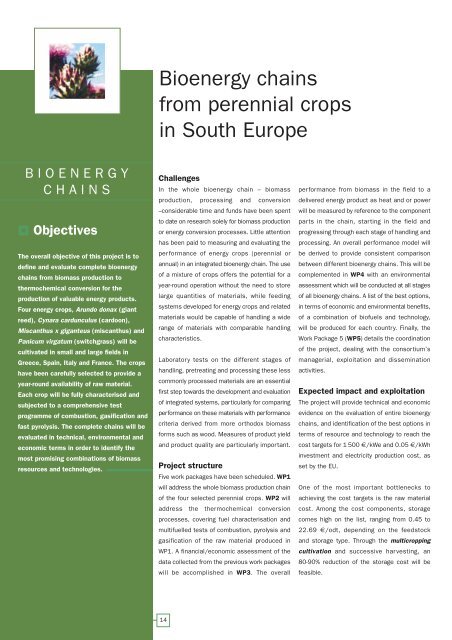European Bio-Energy Projects
European Bio-Energy Projects
European Bio-Energy Projects
Create successful ePaper yourself
Turn your PDF publications into a flip-book with our unique Google optimized e-Paper software.
BIOENERGY<br />
CHAINS<br />
Objectives<br />
The overall objective of this project is to<br />
define and evaluate complete bioenergy<br />
chains from biomass production to<br />
thermochemical conversion for the<br />
production of valuable energy products.<br />
Four energy crops, Arundo donax (giant<br />
reed), Cynara cardunculus (cardoon),<br />
Miscanthus x giganteus (miscanthus) and<br />
Panicum virgatum (switchgrass) will be<br />
cultivated in small and large fields in<br />
Greece, Spain, Italy and France. The crops<br />
have been carefully selected to provide a<br />
year-round availability of raw material.<br />
Each crop will be fully characterised and<br />
subjected to a comprehensive test<br />
programme of combustion, gasification and<br />
fast pyrolysis. The complete chains will be<br />
evaluated in technical, environmental and<br />
economic terms in order to identify the<br />
most promising combinations of biomass<br />
resources and technologies.<br />
<strong>Bio</strong>energy chains<br />
from perennial crops<br />
in South Europe<br />
Challenges<br />
In the whole bioenergy chain – biomass<br />
production, processing and conversion<br />
–considerable time and funds have been spent<br />
to date on research solely for biomass production<br />
or energy conversion processes. Little attention<br />
has been paid to measuring and evaluating the<br />
performance of energy crops (perennial or<br />
annual) in an integrated bioenergy chain. The use<br />
of a mixture of crops offers the potential for a<br />
year-round operation without the need to store<br />
large quantities of materials, while feeding<br />
systems developed for energy crops and related<br />
materials would be capable of handling a wide<br />
range of materials with comparable handling<br />
characteristics.<br />
Laboratory tests on the different stages of<br />
handling, pretreating and processing these less<br />
commonly processed materials are an essential<br />
first step towards the development and evaluation<br />
of integrated systems, particularly for comparing<br />
performance on these materials with performance<br />
criteria derived from more orthodox biomass<br />
forms such as wood. Measures of product yield<br />
and product quality are particularly important.<br />
Project structure<br />
Five work packages have been scheduled. WP1<br />
will address the whole biomass production chain<br />
of the four selected perennial crops. WP2 will<br />
address the thermochemical conversion<br />
processes, covering fuel characterisation and<br />
multifuelled tests of combustion, pyrolysis and<br />
gasification of the raw material produced in<br />
WP1. A financial/economic assessment of the<br />
data collected from the previous work packages<br />
will be accomplished in WP3. The overall<br />
14<br />
performance from biomass in the field to a<br />
delivered energy product as heat and or power<br />
will be measured by reference to the component<br />
parts in the chain, starting in the field and<br />
progressing through each stage of handling and<br />
processing. An overall performance model will<br />
be derived to provide consistent comparison<br />
between different bioenergy chains. This will be<br />
complemented in WP4 with an environmental<br />
assessment which will be conducted at all stages<br />
of all bioenergy chains. A list of the best options,<br />
in terms of economic and environmental benefits,<br />
of a combination of biofuels and technology,<br />
will be produced for each country. Finally, the<br />
Work Package 5 (WP5) details the coordination<br />
of the project, dealing with the consortium’s<br />
managerial, exploitation and dissemination<br />
activities.<br />
Expected impact and exploitation<br />
The project will provide technical and economic<br />
evidence on the evaluation of entire bioenergy<br />
chains, and identification of the best options in<br />
terms of resource and technology to reach the<br />
cost targets for 1 500 €/kWe and 0.05 €/kWh<br />
investment and electricity production cost, as<br />
set by the EU.<br />
One of the most important bottlenecks to<br />
achieving the cost targets is the raw material<br />
cost. Among the cost components, storage<br />
comes high on the list, ranging from 0.45 to<br />
22.69 €/odt, depending on the feedstock<br />
and storage type. Through the multicropping<br />
cultivation and successive harvesting, an<br />
80-90% reduction of the storage cost will be<br />
feasible.

















